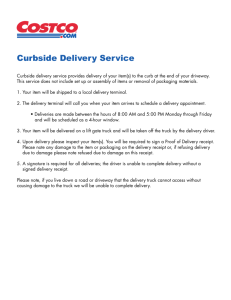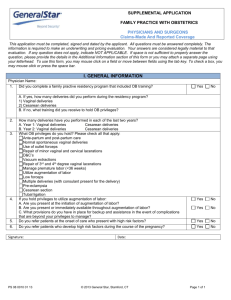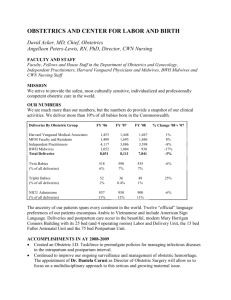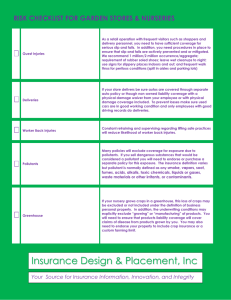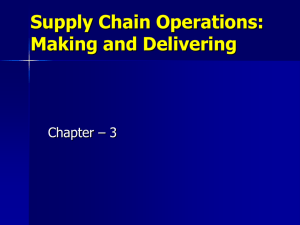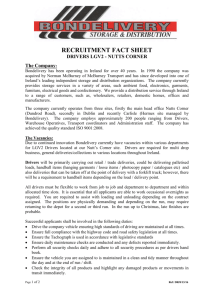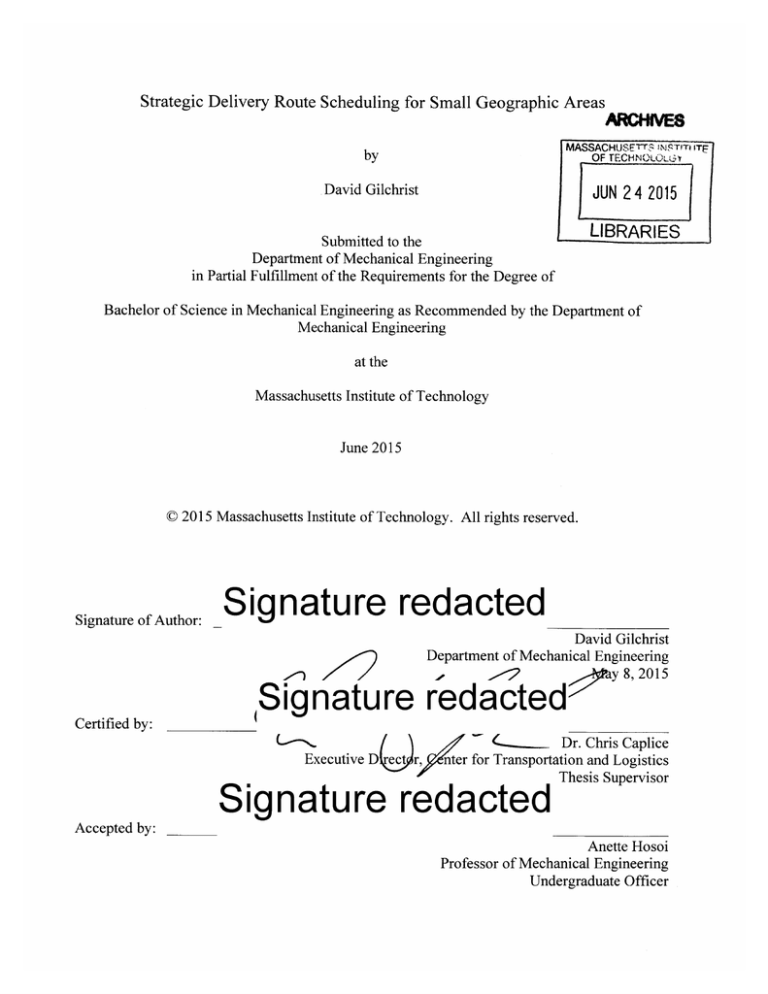
Strategic Delivery Route Scheduling for Small Geographic Areas
MASSACHUSETT
OF TECHNOCLL6
by
David Gilchrist
JUN 24 2015
LIBRARIES
Submitted to the
Department of Mechanical Engineering
in Partial Fulfillment of the Requirements for the Degree of
Bachelor of Science in Mechanical Engineering as Recommended by the Department of
Mechanical Engineering
at the
Massachusetts Institute of Technology
June 2015
C 2015 Massachusetts Institute of Technology. All rights reserved.
Signature of Author:
Signature redacted
David Gilchrist
Department of Mechanical Engineering
ye8,1 2015
-n?
Certified by:
Signature redacted
Dr. Chris Caplice
er for Transportation and Logistics
C.
Executive D
r
Signature redacted
Thesis Supervisor
Accepted by:
Anette Hosoi
Professor of Mechanical Engineering
Undergraduate Officer
rr INSTT ITF
2
Strategic Delivery Route Scheduling for Small Geographic Areas
by
David Gilchrist
Submitted to the Department of Mechanical Engineering
on May 8, 2015 in Partial Fulfillment of the
Requirements for the Degree of
Bachelor of Science in Mechanical Engineering as Recommended by the Department of
Mechanical Engineering
ABSTRACT
The delivery scheduling process of a regional wholesaler was analyzed in order to
develop a more strategic scheduling program. The strategic schedule was designed to utilize
weekly demand history, opposed to daily demand, in order to decrease small batch deliveries, aid
in store inventory management and foster customer relations. This was accomplished with a
linear mathematical program, which produced a standard weekly schedule. A metric for the
maximum days between deliveries was developed to show the improved delivery day
distribution. For the 30 stores analyzed, the average maximum days between deliveries fell from
5.04 days to 3.37 days. The decreased time between deliveries will assist the small stores in
inventory management. Additionally, the standardized schedule will allow storeowners and truck
drivers to develop a productive relationship, which should be able to decrease delivery time and
grow customer relations.
Thesis Supervisor: Dr. Chris Caplice
Tile: Executive Director, Center for Transportation and Logistics
3
4
Acknowledgements
The author of this paper would like to thank Dr. Chris Caplice for his assistance in
guiding him through this project, and Miguel Bethencourt for his corporate knowledge.
5
6
Table of Contents
Abstract
3
Acknowledgements
5
Table of Contents
7
1.
9
Introduction
2. Background
3.
11
2.1 Delivery Routing, Schedule Optimization and Inventory Management
11
2.2 Linear Programming
12
2.3 Demand Variability and Pooling
12
2.4 BeerCo
12
Formulation
14
4. Results and Discussion
16
5. Conclusion
19
Appendix: MATLAB Code
21
Bibliography
23
7
8
1. Introduction
Delivery routing can be a very complex problem that needs to be solved everyday by
businesses across the globe. Typically, a linear program is used to minimize cost, which is
subject to a number of constraints, such as truck capacity and store delivery windows. This paper
studied a beverage wholesaler, which we will call BeerCo, who makes daily deliveries to the
southeastern portion of Massachusetts. Each year, BeerCo's trucks drive approximately 600,000
miles in order to deliver over 9 million cases of beer to 3,000 customers. The fuel costs alone
amount to approximately $500,000, which ignores the cost of truck maintenance and manpower.
Of the roughly 88,000 hours BeerCo drivers spend on the road, 63% of the time is spent
servicing the stores, while the remaining 37% is spent driving between stops.
Prior to this study, BeerCo would take daily sales data and run it through commercial
routing software in order to come up with the optimal delivery route and schedule for the next
day. The software optimizes the routes by minimizing distance traveled and maximizing the
quantity of goods on each delivery truck. The inherent problem with this system is twofold. At
times it was found that stores were placing very small orders, on the magnitude of 5% of their
weekly demand. This meant that in some weeks, stores were receiving multiple deliveries of
small batches in addition to their bulk deliveries. The small deliveries are inherently inefficient
and add to BeerCo's overall logistics cost. Additionally, stores were receiving deliveries from
multiple truck drivers. This prevented truck drivers and storeowners from developing beneficial
business relationships. Many of these customers operate small stores with even smaller
stockrooms. The job of the delivery driver is bring the product into the stockroom and rearrange
it in such a way that older product is at the front and newer product is in the back. When a
delivery driver gains the trust of the storeowner, and understands the particular difficulties in
9
delivering to each store, he is able to develop an efficient system to meet the needs of each store.
This could result in decreased store service times for delivery drivers, which currently amounts
to 56,000 mans hours each year.
In order to address some of these concerns, a standardized delivery schedule was
developed that could foster customer relations, decrease small batch orders and maintain if not
increase overall delivery efficiency. The initial study identified geographically close customers
that had relatively large weekly orders with low standard deviations. These customers offered the
largest immediate benefit without added complexity. The ultimate goal was to create a system of
strategic route scheduling that would incorporate inventory management and customer relations
into the optimization.
The remainder of this thesis is organized as follows. Chapter Two outlines the
background information needed to understand the thesis, which includes a basic explanation of
linear programming, delivery routing and scheduling, inventory management, risk pooling as
well as an introduction to BeerCo. In Chapter Three we describe the linear program used to solve
the scheduling problem. Chapter Four describes the results of the linear optimization. In Chapter
Five we provide conclusions of the research and areas of future research.
10
2. Background
2.1 Delivery Routing, Schedule Optimization and Inventory Management
Delivery size and store location are two of the most important factors in determining
delivery routes and schedules. This study assumes that geographically clustered stores have been
previously identified, which means that distance between stores can be ignored. On the other
hand, the size of each delivery will have a serious impact on routing decisions. The most obvious
impact of delivery size is on truck capacity. A truck can only deliver as much as its capacity
dictates, which can prevent one truck from delivering to multiple large stores. Having a fleet of
different sized trucks can help maximize truck utilization, but it is important to note that filling
the largest trucks to capacity will result in the most efficient routes (Ballou 1992).
Reducing the number of deliveries to a store will always improve delivery cost, but it will
not necessarily increase the effectiveness of the entire supply chain. Once a delivery has been
made, the store is responsible for holding that inventory, which takes up valuable stockroom
space. The typical BeerCo customer will carry hundreds if not thousands of different products,
all of which are fighting for both shelving and stock room real estate. Due to store inventory
constraints, it is sometimes not possible for a store to hold two or even one week of demand for
all products. This constraint requires that many of the stores require a minimum of two deliveries
each week, and some stores even more.
The days in which deliveries are made are also critical to proper inventory management.
If a store receives two deliveries each week, but they are made on back-to-back days, the store
will be holding six or more days of inventory. A store needs time to deplete inventory after a
delivery is made to free up space for the next delivery. Thus, in the case of two delivery days per
week it makes sense to spread the deliveries out over the week, the ideal case leaving a
11
maximum of three days between deliveries. In the case of three deliveries per week the optimal
solution leaves at most two days between deliveries.
2.2 Linear Programing
Linear programming is tool used to determine the optimal solution to a problem
described by linear relationships. An objective function drives the program to its solution by
relating the decision variables in a way that a maximum or minimum solution will produce the
optimal result. The decision variables are ultimately the outputs of the program, and are
incrementally changed until an optimal solution is found. The decision variables can be related to
a series of constraints in the form of mathematical equalities and inequalities. Additionally,
decision variables can be integer, non-integer and binary.
2.3. Demand Variability and Pooling
An additional source of complexity in delivery routing is demand variability. Accurate
forecasting models are hard to come by, which makes designing delivery routes more than a
week in advance difficult. One method to combat demand variability is pooling, which occurs
naturally on any delivery truck delivering to two or more stores. A delivery truck may deliver to
a dozen stores each with an average weekly demand and standard deviation. Pooling is
essentially a bet that a few of those 12 stores will be above average, while the others will be
below average. This results in the "pooled" average having a lower standard deviation.
2.4 BeerCo
BeerCo services approximately 3,000 stores and restaurants in southeastern
Massachusetts. Their product line is diverse and has high market share in the region. Their
12
customers range drastically in size from small restaurants that order a half dozen cases per week
to large stores that process over 2,000 cases per week. BeerCo strives for a very high level of
service, which has led them to use a flexible daily routing system. Software will process all sales
orders overnight, and route them for next day delivery to the customer. This daily optimization
makes for a highly flexible delivery network, but often ignores potential advantages that could be
gained from weekly planning.
13
3. Formulation
Thirty of BeerCo's customers were identified from the greater Boston area. These
customers were chosen because of their shared geographic proximity and relatively consistent
high demand. Four months of daily delivery data was examined and broken down by weekly
demand, weekly deliveries and delivery size. Utilizing this data, a linear program was designed
to create weekly-standardized schedules for the stores.
minimize:
Yij
Subject to:
0 for all i andj
(1)
Xi - MYj
(2)
Xi
(3)
Xij = D for all i
C for all j
(4)
~Yi j>-F
(5)
Y + Yitj+)
1
Where:
Indices:
i:
-
j:
Decision Variables:
X;: -:
Y;:
-
-
The customer receiving the shipment, i= 1,2,
The day of the weekJ = 1,2,...n
...
m
The number of cases to be shipped to store i on dayj
= 1 if store i will receive a shipment on dayj; = 0 otherwise
Data:
M: 4
C;:
D 4
Fi: 4
-
-:
An arbitrarily large number relative to the maximum value of Xi;
The truck capacity for dayj
The average weekly demand for store i
The minimum number of deliveries per week for store i
Figure 1: Mathematical formulation of the linear program
14
The objective function in Figure 1 that set out to minimizes the number of deliveries per
week. In order to obtain this, two decision variables were required. The first was an integer
variable, Yij, which took on the form of either 0 or 1. If Yy was 1 it represented the fact that store i
received a delivery on dayj, whereas a 0 represented no delivery. The other decision variable,
Xy, represented the volume of product being delivered in cases to store i on dayj. In order to
represent the 30 stores and 5 delivery days, Monday through Friday, a total of 300 variables were
required.
The first constraint is a forcing constraint used to link Yj to Xy. Or in other terms, Equation
I was used to ensure that when X# was nonzero, Y# would equal one. Next, a daily truck capacity
constraint, Equation 2, was used to limit daily shipments. Then, a weekly demand equality was
used to ensure that each store would receive their average weekly demand, Equation 3.
Equation 4 assigned each store a minimum number of deliveries per week. While
Equation 5 ensured that a store would not receive deliveries on back-to-back days. Both of these
constraints were designed to help distribute inventory over the course of the week in order to
assist stores in inventory management.
These 5 equations characterize the linear program used to create the standardized
schedule. MATLAB software was then used to solve the program, which allowed for easy
adjustments to the various constraints. The code used can be seen in the Appendix, MATLAB
Code.
15
4. Results & Discussion
The linear programs easily produces a solution within the given constraints, but the
benefits are not immediately clear. Each store receives two deliveries per week except for the
three stores that have weekly demand of roughly 1,000 cases or more, who receive 3 deliveries
per week. This results in a total 63 deliveries per week with approximately equal volume being
shipped each day.
Table 1: An example of five stores weekly deliveries. All quantities are in units of cases.
Delivery
Day
Monday
Tuesday
Wednesday
Thursday
Friday
Total
Store 1
341
0
342
0
341
1,024
Store 2
0
171
0
342
0
512
168
163
0
0
0
234
0
326
0
336
0
0
0
504
489
0
116
350
672
405
668
678
458
5,763
Store3
Store 4
Store5
Daily Total
As seen in Table 1, the delivery days for each store are spread throughout the week. The
metric used to quantify this distribution is the maximum number of days between deliveries in
the week. For instance, if a store received deliveries on Monday and Thursday the maximum gap
between deliveries would be Friday to Sunday, which is three days. A lower maximum
represents a better-distributed schedule, which results in improved inventory management at the
store. The program's solution produced an average maximum of 3.37 days between deliveries for
the 30 stores. In order to compare this metric to the previous system, four random weeks were
selected from the historical data, one from each month of data to eliminate potential seasonal
trends. The average maximum time between deliveries over these four weeks was 5.04 days.
16
Table 2: The average maximum number of days between deliveries for historical data
and the newly generated schedule
New Schedule
3.37 Days
September
5.17 Days
October
5.07 Days
November
5.40 Days
December
4.43 Days
Average
5.04 Days
Figure 2, below, shows the same data in histogram form. It can be seen that the historical
data, in red, is comprised mostly one-day delivery weeks, which leaves six days between
deliveries. On the right side, the optimized solution shows that the majority of stores receive
multiple deliveries spread out over the course of the week.
-
25
-
20
Co
C M~
E5
*R
15
10
0
0
U
0
2
3
4
5
6
7
Maximum Number of days Between Deliveries
Figure 2: Histogram of the maximum days between deliveries in the historical data in red. The
red bars represent historical data, while the blue bars represent the proposed solution.
Thus far, the optimization has assumed that each store receives the average weekly
demand each week, but this is not a realistic scenario. The first way that the model accounts for
this variability is through pooling. Each delivery day in the standardized route schedule has an
average of 12.60 stops, which means that on average 12 stores are being delivered to each day.
17
Operating under the assumption that the variance in demand is uncorrelated, the average demand
for each delivery day should remain fairly constant. The stores with below average demand will
leave capacity for the stores with higher than average demand. As the number of stops per day
increases, the effects of pooling should decrease daily demand variability.
Table 3: The average deliveries per day for the proposed route compared to the average
deliveries per day of the historical data
Average
Friday
Wednesday Thursday
Tuesday
Monday
8.10
12.00
5.00
11.50
7.00
5.00
Historical
12.60
16.00
10.00
9.00
15.00
13.00
Proposed
The second way that demand variability was addressed was through sensitivity analysis.
The model was run under the extreme case that one half of the stores received their average
demand and the other half received their average demand plus one standard deviation. This
represents the most extreme case seen in historical data were the weekly demand for the 30
stores approached 21,000 cases, opposed to the average 16,000 cases. This situation would
require added truck capacity, but the model was able to distribute this need evenly over the week.
This result will allow BeerCo to assign larger trucks to certain drivers over the course of the
week, instead of adding a new route. Lastly, it is important to note that the proposed delivery
volumes represent the average delivery size, and should be used as the middle point in a range of
values, opposed to exact quantity.
18
5. Conclusion
This study set out to create a method for strategic delivery route scheduling. It was found
that through the use of linear programming, a weekly delivery route schedule could be developed
that decreases the average days between deliveries from 5.04 days to 3.37 days. This allows
storeowners to better manage their stock room inventory, by lowering their average daily
inventory. Additionally, the proposed schedule has the potential to decrease service times by
increasing delivery driver customer knowledge. The standardized schedule results in drivers
servicing the same stores each week, which allows them to customize their delivery process at
each store. Lastly, the standardized schedule will allow storeowners and sales representatives to
plan deliveries over the course of the week, which should eliminate the need for last minute
small batch orders.
It is important to note that this strategy would not be optimal if applied to 100% of the
delivery volume. By implementing this approach to the total average demand minus one standard
deviation, a wholesaler could maintain a high truck capacity utilization, and therefore maintain
delivery route efficiency. If this strategy were implemented to all demand, capacity utilization
would drop, because the schedule would not be able to account for variation in demand.
If future investigation into this topic were conducted, there are several areas that would
warrant exploration. First, the schedule was just recently implemented on a small scale at
BeerCo, which means the impact on delivery driver service time has not been investigated. Once
these data becomes available, it would be beneficial to determine whether or not service time
decreases. Additionally, this study focused on only 1% of BeerCo's customers. There is still
much to be understood on the impact of overall logistics costs if this were to be applied to a
19
majority of the customers. For instance, the percentage of volume that could be handled using
this strategy without impacting truck capacity utilization.
20
Appendix: MATLAB Code
% Objective functions components
y_ij = repmat(1,150,1);
x-ij = zeros(150,1);
%objective function
f = [y-ij; x-ij];
%lower bound of x and y
lb = zeros(300,1);
%upper bound components
uby = repmat(1,150,1);
ubx = 1.4*maxdelivery;
demand
%upper bound of each delivery relative to weekly
% upper bound of all variables
ub = [uby ; ubx] ;
% range of integer variables
intcon = [1:150];
% formulation of inequality coefficient matrix
%daily capacity constraint
one_30 = repmat(1,1,30);
mon demand = [zeros(1,150) , one_30, zeros(1,120)];
tuesdemand = [zeros(1,180) , one_30, zeros(1,90)];
weddemand = [zeros(1,210) , one_30, zeros(1,60)];
thursdemand = [zeros(1,240) , one_30, zeros(1,30)];
fri demand = [zeros(1, 270) , one_30];
A_daily-capacity = [mon_demand; tues demand; weddemand;
thurs demand;
fridemand];
%min delivery day constraint
A_deliveryday = -mindeliveryconstraint'
%correlate x and y
A-x = diag(repmat(-2000,1,150));
= diag(repmat(1,1,150));
Ay
A-xy = vertcat(Ax,Ay);
%non consecutive delivery days
A_nonconsec = StoresandAveragesS2'
%inequality coefficient matrix, A
A = vertcat(Adailycapacity,Adeliveryday,Axy',
%inequality vector,
Anonconsec);
B
B = [repmat(4400,1,5), repmat(-2,1,30), repmat(0,1,150),repmat(1,1,120)]';
%equality coefficient matrix, AEQ
AEQ = weeklydemandconstraint';
21
%equality vector, BEQ
BEQ = halfstd(1:30);
%solution
[solution,fval,exitflag,output]
= intlinprog(f,intcon,A,B,AEQ,BEQ,lb,ub);
22
References
Ballou, Ronald H. Business Logistics Management. Third Edition. Englewood Cliffs, New
Jersey: Prentice Hall, 1992.
23

